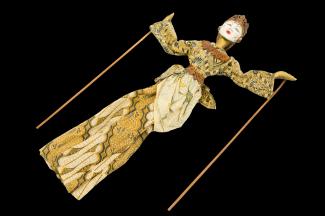This modern Sita (Sinta) puppet from Bali, Indonesia is a central figure from the ancient Indian Hindu epic Rāmāyana (Life of Rama). The puppet wears a Surakarta batik dress decorated with parang and sidomukti motifs. This Sita puppet was donated to the Western Australian Museum as part of a group of wayang golek figures acquired by a collector of Southeast Asian curios.
Origins of wayang golek
Wayang golek puppet theatre originates from the Sundanese areas of West Java and is among the world’s oldest puppetry traditions. Wayang depicts the struggle between right and wrong, and is performed by a dalang (puppet master) who is considered both performer and shaman or intermediary between the material and spirit world. Gamelan music is the foundation of each performance.
The role of wayang in the spread of religion
Wayang golek wooden puppets are carved and decorated to resemble characters from the Rāmāyana (Life of Rama), the epic story of Prince Rama’s struggle to regain his wife, Sita (Sinta), from the rakṣaka (a demonic creature in Hindu mythology) king Ravana (Rahwana) and Mahābhārata (Great Chronicle of the Bharata Dynasty) which tells the struggle of the five Pandava (Pandawa) brothers to regain their kingdom from their cruel Kaurava (Kurawa) cousins. In Javanese, the word golek means ‘to find’. During a performance, the audience is expected discover the true essence of meaning behind each inspirational tale. Wayang menak or wayang cepak refers to puppet stories from the north coast of Java which emerged with the adoption of Islam. Gradually, indigenous tales and Hindu epics were adapted to the philosophy of Islam. Over the centuries, wayang has been adapted and used to disseminate religious values in Indonesia.

